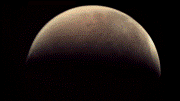Update from MEX Spacecraft operations Engineer Simon Wood at ESOC
The commands to run next week’s observations are now all confirmed on board Mars Express!
To give an idea of what these commands are and what they look like, here is a screen shot from the mission control system showing the commands on board for the first observation orbit on Monday, 25 May.
In essence, they are broken down into three groups: turning the spacecraft away from Earth (we call this a ‘slew’), the observation itself and then the slew back to pointing at Earth.
For the first group, the slew away, we first have a command to set what we call the ‘out of Earth timeout’; this starts a timer by the end of which the spacecraft must be back to Earth pointing. If it is not Earth pointing when the timer expires, then the spacecraft will put itself in safe mode.
This is a precaution that is taken for every pointing we do; in the event of a problem, the spacecraft won’t get stuck pointing the wrong way.
There are then the commands to update the mode in which the attitude and orbit control system (AOCS) is in and to tell the craft to start to slew. Finally, there are commands to update the position of the solar arrays to ensure that when the spacecraft has turned to its new attitude, that sufficient power is being generated.
Once in position, we can then start the observation.
Here we have the command to start the on-board control procedure (OBCP), which is a small computer program that runs on board the spacecraft and that controls the VMC camera. This program switches on and initialises the camera (this takes around two minutes) and then it enters into the programmed observations.
For the VMC Schools Campaign, this is means taking approximately 1 image per minute, cycling through 3 exposure settings. As this is a long-duration observation, there are also a group of commands that will keep updating the AOCS such that it keeps turning the spacecraft to keep Mars in the view of VMC.
The final group is the end of observation activities. Here we start another OBCP, which switches VMC off. Then the solar arrays are commanded to rotate again to optimise the power output and AOCS is then commanded to turn the spacecraft so the antenna is pointing at Earth.
After that, the transmitter will then switch on and the on-board computer will begin sending the VMC images back to Earth.
– Simon Wood





Discussion: no comments